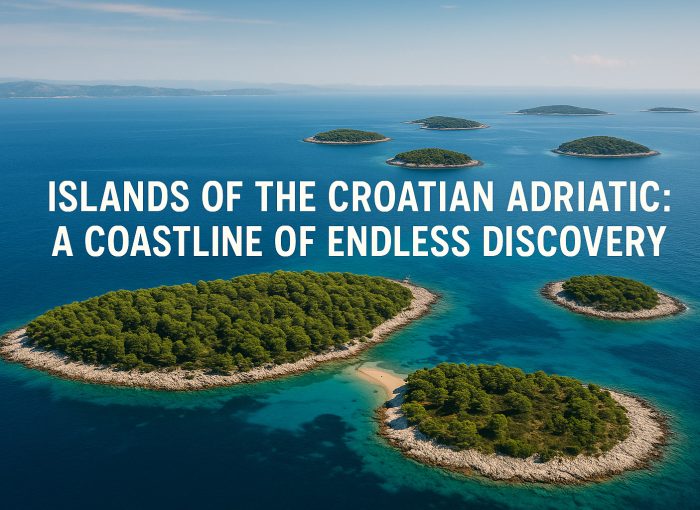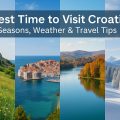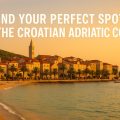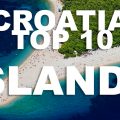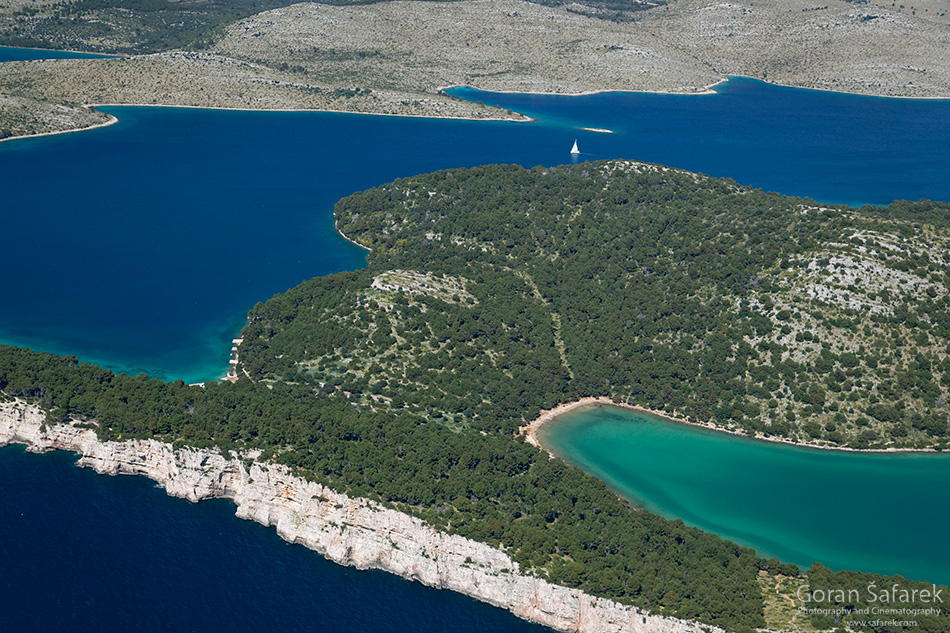Discover Croatia’s Adriatic islands—rocky gems of the Mediterranean where pine forests, hidden coves, and wild beauty meet tradition and tranquility.
Table of Contents
Sprinkled like emerald jewels across the eastern Adriatic, the Croatian islands are the soul of the Mediterranean in its purest form. With over 1,000 islands, islets, and reefs, this coastal wonderland unfolds along nearly 6,000 kilometers of rugged shoreline. From craggy cliffs to sheltered bays, the landscape is wild, diverse, and deeply enchanting. Pines line the ridges, cicadas sing through the heat of the day, and the scent of salt and rosemary floats on the breeze. Whether you’re searching for solitude, a vibrant beach bar, a hidden naturist cove, or just the simple joy of swimming in crystal-clear water—the Croatian Adriatic has it all. This isn’t just a destination; it’s a feeling, a rhythm, a return to something timeless.
The Ancient Origins of the Croatian Islands
Long before the first boat ever sailed these blue waters, the Croatian islands were not islands at all. During the Ice Ages, when vast amounts of the Earth’s water were locked away in glaciers, sea levels were over 100 meters lower than today. What we now call islands were once the high ridges and rolling hills of a rugged karstic landscape—part of the craggy Dinaric Alps, stretching across the hinterland and dipping into the Adriatic.
As the ice melted and the sea crept back in, valleys became sea channels, and peaks became islands. This unique geological transformation left behind a coastline of stunning complexity—a lacework of peninsulas, islets, and fjord-like bays.
At the heart of this transformation is limestone, the dominant rock of the Croatian coast and islands. These rocks tell an even older story, one that begins more than 100 million years ago in a shallow, tropical sea. This was the Adriatic Carbonate Platform, a vast seabed built up over eons by the slow rain of tiny plankton skeletons. Layer upon layer of this biological snowfall created a thick sedimentary platform, which was later uplifted by powerful tectonic forces, as the African plate slowly collided with Europe.
The result? A dazzling, sharply sculpted coastline—one of the most spectacular anywhere in the Mediterranean—where geology meets history, and every stone has a story.
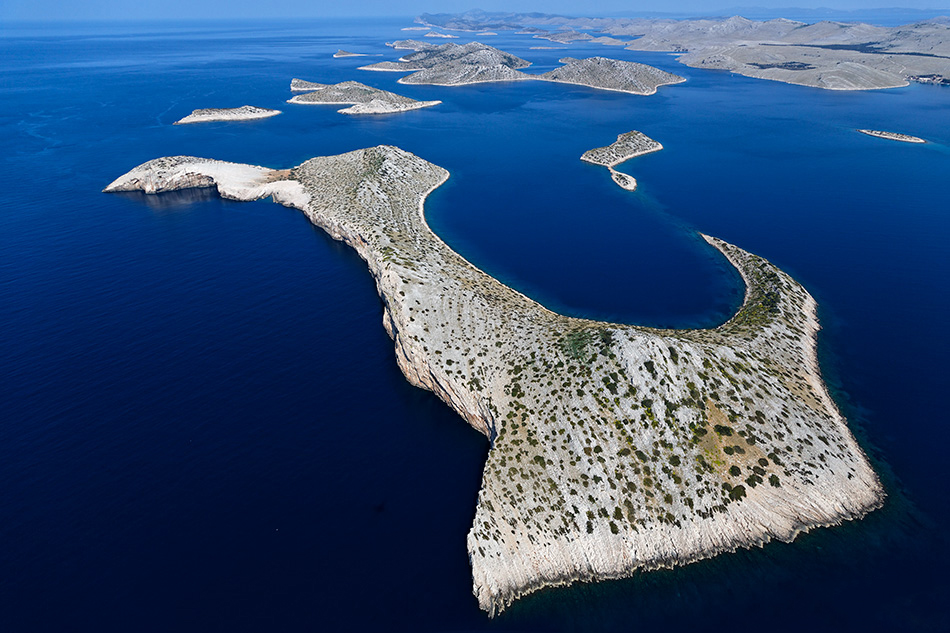
Islands of Croatia by Region
With over 1,200 islands, islets, rocks, and reefs, Croatia’s coastline is one of the most indented in the world—thanks to the ancient limestone (karst) bedrock that fractures into dramatic forms. From lush green islands to lunar-like landscapes, each region tells a different story. Here’s how the archipelago unfolds, from the gentle coves of Istria to the volcanic islets far offshore.
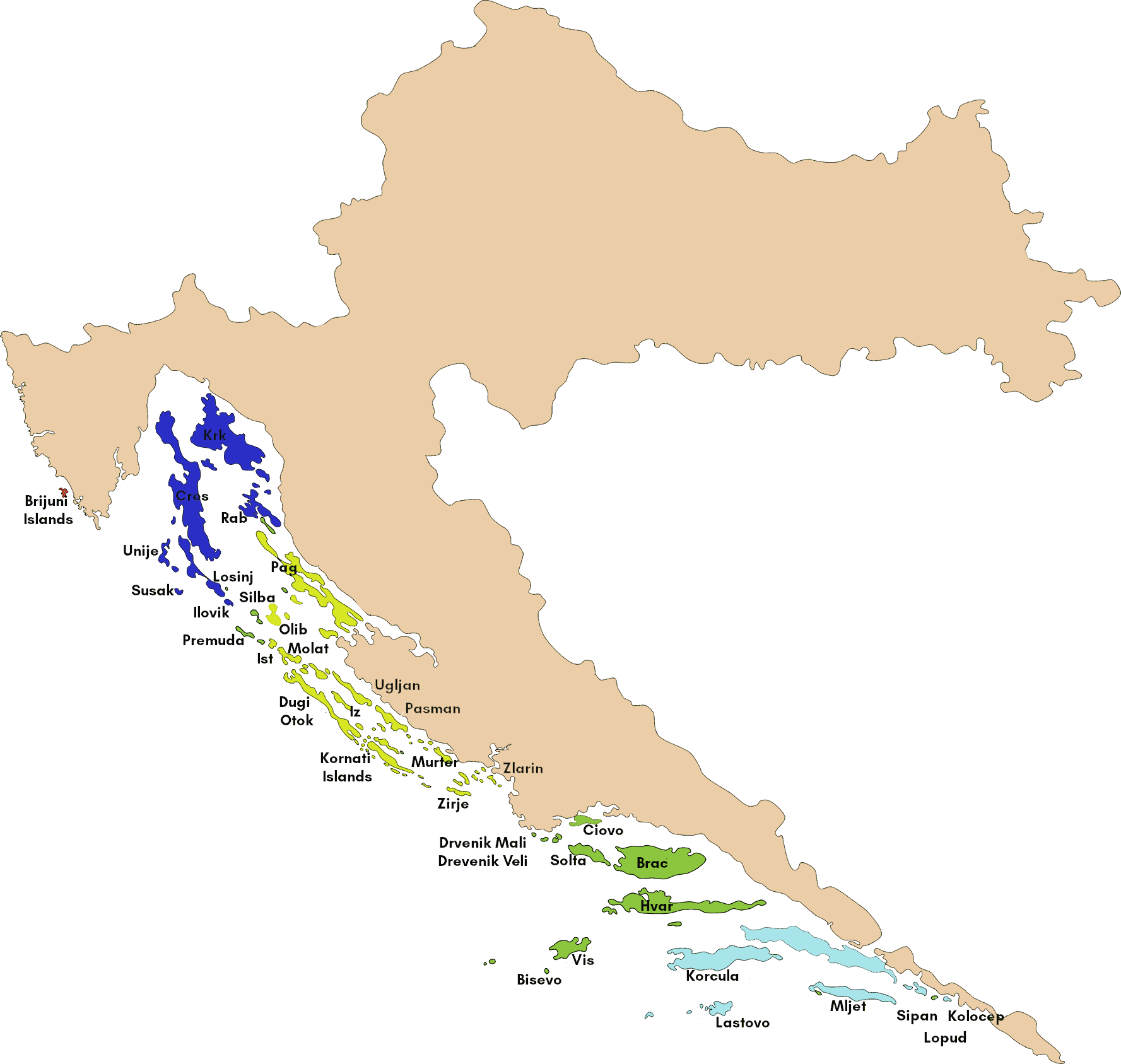
Istria: Gentle Beginnings
Istria’s island count is modest, but meaningful. The Brijuni Islands, once the summer playground of nobility and presidents, now form a national park of emerald pines and Roman ruins. They are the largest group off Istria’s coast, set against a mostly mainland-focused region. Other than Brijuni, Istria’s coastline is more about peninsulas than archipelagos—though its proximity to the Kvarner Bay sets the stage for what’s to come.
Kvarner: Where the Mountains Meet the Sea
Between the imposing slopes of Mount Učka and the wild backbone of the Velebit Mountains, the sea carves deep into the land to form the Kvarner Gulf—a dramatic meeting point of stone and salt, of wind and island. This is the northern gateway to Croatia’s archipelago, and home to some of the largest and most culturally vibrant islands in the country.
The twin giants of the region are Krk and Cres—so close in size that for decades, there was debate about which of the two was bigger. Both islands cover around 405 km² and boast a long human history, from Roman ruins to medieval hilltop towns, but each has its own rhythm. Krk, connected to the mainland by a bridge, is the more accessible and developed of the two, with busy coastal villages, vineyards, and sandy beaches.
Cres, by contrast, remains wilder and more remote. Its landscape is steep and stony, dotted with dry-stone walls, olive groves, and hidden shepherds’ paths. Inland, Lake Vrana—a vast freshwater reservoir—lies in quiet contrast to the surrounding karst terrain, and the ancient hilltown of Lubenice perches on a cliff like a stone eagle’s nest, watching the sea.
To the south, Lošinj curves gently into view, connected to Cres by a narrow channel carved centuries ago. Known as the “Island of Vitality,” Lošinj has long drawn visitors for its mild climate, lush vegetation, and wellness traditions. Aromatic herbs scent the air, dolphins swim just offshore, and seaside promenades lead past Austro-Hungarian villas shaded by pine trees. The town of Mali Lošinj, once a shipbuilding hub, has become a charming blend of heritage and elegance.
Further east lies Rab, a unique island with two faces. Its windward side, exposed to the fierce bura wind that sweeps down from the Velebit, is stark and bare, its rocks bleached by salt and time. But the leeward side is a world apart—green, lush, and gentle, with sandy beaches like those of Lopar, a rarity in rocky Croatia. Rab Town, with its four bell towers rising over ancient stone alleys, is one of the architectural jewels of the Adriatic.
Scattered beyond the main islands are smaller, quieter gems that carry the soul of the sea in their silence. Susak is perhaps the most unusual of them all—an island made not of limestone, but of fine yellow loess, carried by wind and rivers from the ancient Po basin. Its soft, sandy soil supports vineyards and wild herbs, and its traditional costumes—high boots, bright skirts—are unlike anywhere else in Croatia. Unije and Ilovik are peaceful and car-free, where bicycles and boats are the only way to get around. Silba, beloved by artists and dreamers, is a poetic place of pine groves and sculpture-lined paths. Nearby, the tiny Srakane islands feel like stepping into another century—no cars, no crowds, just the rhythm of the waves and the creak of old wooden doors.
Then there are the windswept, forgotten islands like Goli Otok, Sveti Grgur, and Prvić, bare and stark as stone can be. These were once places of exile and political imprisonment, especially during Yugoslavia’s darkest decades. Today, they stand silent and solemn, their crumbling walls echoing with history and the shrill cry of seabirds. Little vegetation grows here, and the wind never truly rests—but the views are endless, and the sense of isolation strangely moving.
Northern Dalmatia: The Maze of the Adriatic
If the Adriatic were a tapestry, then the Zadar–Šibenik archipelago would be its most intricate embroidery—an elaborate maze of land and sea stitched with capes, coves, and countless islands. Nowhere else in Croatia does the coastline fracture so delicately, carving hundreds of shapes from ancient stone, where the islands seem to float like stepping stones across a glittering blue expanse.
The gateway to this watery labyrinth is Pag, an island that doesn’t quite look real. Swept constantly by the bura wind that barrels down from the Velebit mountains, Pag’s barren ridges and cracked, silver rock give it a lunar appearance. Yet beneath this starkness lie a wealth of traditions: salt pans, lace-making, and the sharp, herb-infused cheese for which the island is famous.
As you sail south and west, the landscape softens into a long ribbon of elongated islands. Dugi Otok, or “Long Island,” lives up to its name with pine-scented cliffs and the stunning sea-lake of Telašćica, a natural bay surrounded by dramatic limestone walls. Its smaller siblings, Pašman and Ugljan, stretch along the mainland like guardians of the coast, green and cultivated, their hills striped with olive groves and quiet villages.
Between these larger islands and the open sea lie scattered pearls of every shape and size. Iž, with its earthy, artistic soul; Silba, where cars are banned and life slows to the rhythm of footsteps; Premuda, Olib, and Ist, beloved for their tranquility and traditional charm.
Near Šibenik, Zlarin, once famed for coral diving, and Krapanj, the flattest and smallest inhabited island in Croatia, both offer peaceful retreats just minutes from the mainland. Prvić Island harbours two beautiful villages. Žirje, the farthest flung, keeps watch over the edge of the archipelago, covered in pine and dry-stone walls, touched only lightly by time.
But at the heart of Northern Dalmatia’s watery maze lie the Kornati Islands—a place of stark, surreal beauty. Numbering over 150 islands, islets, and reefs, the Kornati are the densest archipelago in the Mediterranean, formed by a collision of tectonic forces and sculpted further by centuries of grazing sheep and goats, which stripped them bare. What remains is something elemental: a dreamscape of white stone and deep sea, with dry-stone boundaries crisscrossing the slopes like the veins of the earth.
Sailors often call the Kornati “a nautical stone lace”—a place where you don’t walk between islands, but sail between ideas. Designated as a national park, the Kornati are protected not just for their nature, but for their profound silence, their wild winds, and the way they make you feel like you’ve slipped out of time.
Just off the mainland near Šibenik lies Murter, an island that feels more like a seaside village than a separate world. Connected by a small bridge, Murter is beloved for its charming old towns, olive groves, and access to the Kornati Islands, as many of the archipelago’s traditional boat owners and caretakers come from here. Its coves, like Slanica Bay, draw families and sailors alike, blending simplicity with maritime spirit.
Northern Dalmatia is where geography becomes art, where navigation turns into meditation. Whether you’re sailing, hiking, or simply gazing from a sun-drenched port, this region invites you to get lost—in the best possible way.
Central Dalmatia: The Classics
If Northern Dalmatia is the wild maze of the Adriatic, then Central Dalmatia is its grand stage—home to the islands that have become icons of Croatian travel, gracing postcards, guidebooks, and daydreams for decades. This is where tradition and glamour, stone and sea, converge in perfect harmony.
Closest to the mainland is Brač, the third-largest island in Croatia and a place where time feels balanced between heritage and tourism. Its crown jewel is Zlatni Rat, the golden spit of shifting pebbles that juts confidently into the sea at Bol, one of the Adriatic’s most photographed beaches. But beyond this dazzling shore lies a quieter world: stone-roofed villages, wind-sculpted olive trees, ancient quarries that supplied white stone for Diocletian’s Palace in Split—and possibly even the White House. Inland, dry hills hum with bees, and the breeze carries the scent of immortelle and pine. Brač is sturdy, honest, sun-washed—a place built to last.
Just a short ferry ride away is Hvar, Croatia’s sunniest island and arguably its most famous. It has long held a magnetic pull for poets, jet-setters, and travelers in search of light and luxury. Hvar Town shimmers with marble streets, Venetian palaces, and lively cafés facing a perfect crescent-shaped harbor. Above it all, the Fortica fortress stands guard, offering sweeping views of the Pakleni Islands scattered offshore. But the island is not all sparkle. Inland, lavender fields bloom in the summer heat, and remote hamlets like Humac whisper stories of shepherds and saints. Hvar is complex—both glamorous and grounded, modern and ancient, wild and refined.
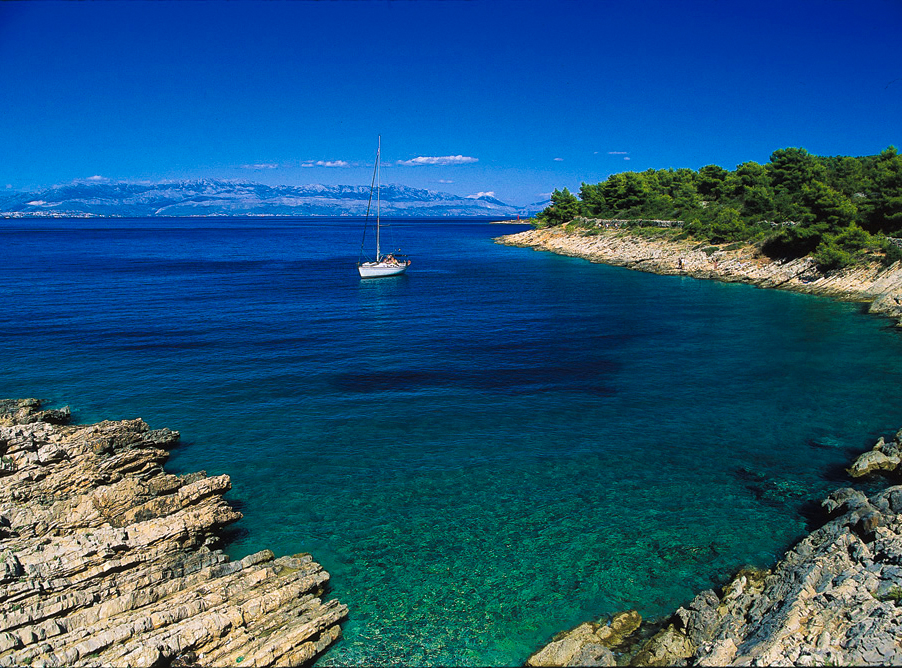
Closer to Split, but worlds away in spirit, is Šolta—a peaceful, pine-clad island that often slips under the radar. Here, fishermen still mend nets by hand, donkeys bray from olive terraces, and the scent of rosemary clings to the air. Maslinica, its most picturesque village, has quietly become a boutique destination, with a small marina and a 300-year-old castle-turned-hotel. The island’s pace is slow, but its authenticity is strong. Šolta reminds you that island life isn’t just scenery—it’s a way of being.
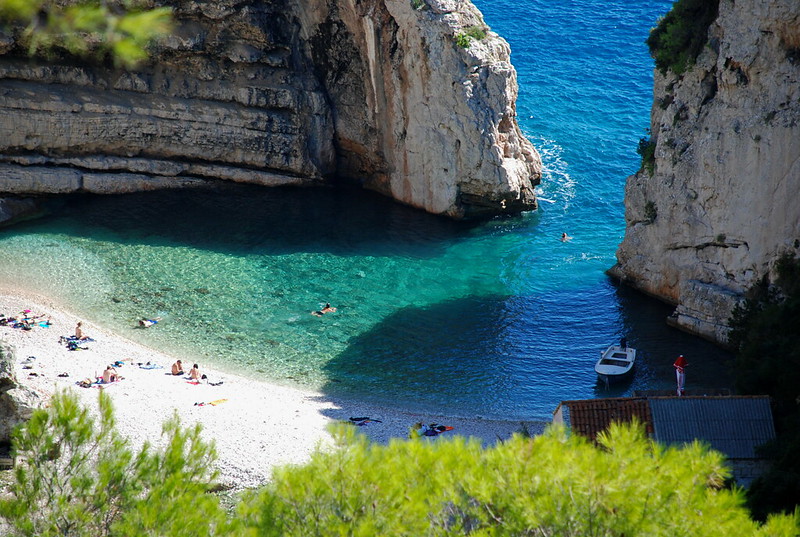
Then, furthest out to sea, lies Vis—mysterious, magnetic, and deeply loved. Vis was a military island until the 1990s, closed to foreigners for decades, which preserved its quiet rhythm and shielded it from overdevelopment. Even today, arriving at Vis feels like entering a secret. Its two main towns, Vis and Komiža, are sleepy and sun-drenched, where stone houses lean gently against each other and cats rule the cobblestone lanes. Offshore lie natural wonders like the Blue Cave of Biševo, and inland, abandoned military tunnels hint at the island’s complex past. Vis is for those who linger—explorers, artists, romantics who come not to see, but to feel.
Southern Dalmatia: Deep Green and Timeless
As the Dalmatian coast stretches toward its southernmost reaches, it begins to soften and deepen. The cliffs grow gentler, the vegetation lusher, and the rhythm slower. This is Southern Dalmatia—a region where the Adriatic breathes more calmly, where ancient forests meet the sea, and where the islands seem to float between myth and memory.
The northern threshold of this region is Korčula, often called “Little Dubrovnik” for its striking walled town and red-roofed skyline. But Korčula is more than a pretty facade. It is one of Croatia’s most storied islands, with a rich medieval core and a deep vein of cultural pride. Said to be the birthplace of Marco Polo, it has long been a crossroads of East and West, of merchant ships and island traditions. The island is covered in vineyards, pine woods, and olive groves, and its people are known for preserving ancient dances like the Moreška sword dance, performed in costume as it was centuries ago. Korčula is elegant yet earthy—a place where every step feels steeped in meaning.
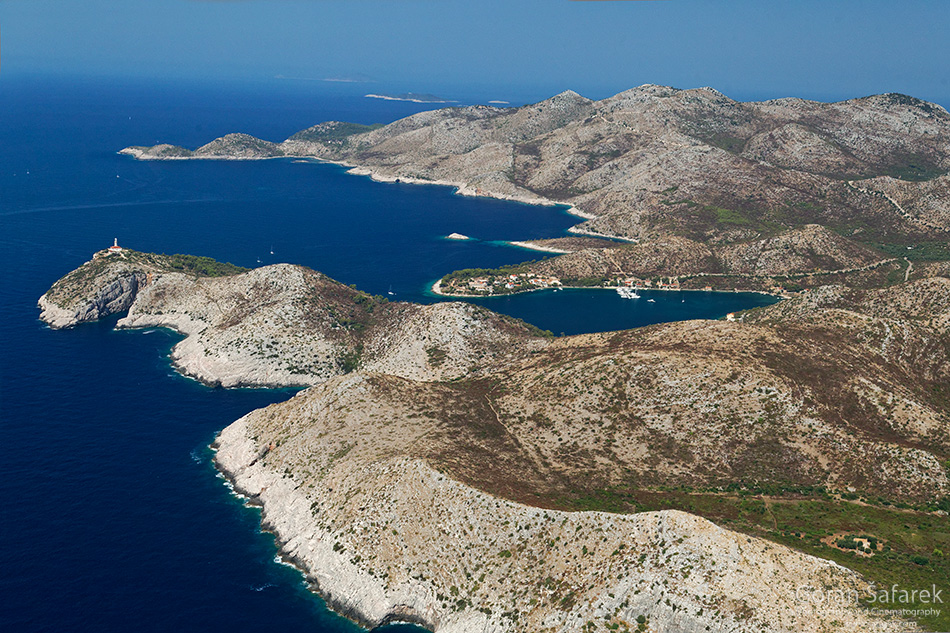
Southeast of Korčula lies Lastovo, an island apart, almost secret. Once a military zone closed to foreigners, it’s now a sanctuary of silence and stars. Designated a Nature Park, Lastovo is cloaked in deep green forests and dotted with stone villages that seem forgotten by time. Unique to Lastovo are the fumari—chimneys of fantastical shapes, each one different, rising from houses like sculptures. This island doesn’t reveal itself easily, but for those who seek solitude, authenticity, and a sky full of stars, there is no better place.
To the east, Mljet stretches long and narrow toward the open sea. This island is a world of green, covered in thick Aleppo pine forests that dip right into the water. Its western end is protected as Mljet National Park, a tranquil expanse of two saltwater lakes, an islet monastery, and shaded trails ideal for walking or cycling. According to legend, Mljet is the island where Odysseus was held captive by the nymph Calypso—and it still feels like a place you might never want to leave.
Closest to the mainland and Dubrovnik lie the Elafiti Islands: Šipan, Lopud, and Koločep. Though small, they are full of charm. Koločep is car-free and covered in subtropical vegetation. Lopud boasts soft sandy beaches and a restored Franciscan monastery. Šipan, the largest, is a sleepy oasis of stone villas and citrus groves. All three are perfect for day trips or quiet overnights, and are just a short ferry ride from the city’s rush.
While the mainland in this region features the Pelješac Peninsula—a rugged, wine-rich stretch of coast that feels like an island—Southern Dalmatia’s true magic lies offshore, in its sense of remove. These islands are deeply rooted in nature and history, and somehow untouched by the passing of time. Their isolation helped preserve dialects, customs, and architecture, and their landscapes still echo with shepherds’ songs and church bells, with the hush of waves in secluded coves.
Here, the Mediterranean still feels wild, and the Adriatic not only shines but remembers.
Faraway and Unusual Islands: Edges of the Adriatic
Beyond the main island chains, past the sunlit paths of ferries and sailboats, lie Croatia’s most remote and extraordinary islands—rugged outposts that feel like the Adriatic’s whispered secrets. These islands don’t follow the rules of gentle beaches and tourist ports. They are wild, volcanic, windswept—and sometimes barely above the surface.
The most isolated of them all is Palagruža, a rocky ridge rising from the open sea, almost equidistant between Croatia and Italy. Lashed by waves and wind, Palagruža is home to a lighthouse, a few ruins, and nothing else. Yet it was once a sacred place to the Illyrians and Greeks, and archaeological remains suggest ancient rituals and seafaring myths. Today, it stands as a lonely beacon—a symbol of endurance and mystery at the edge of the Adriatic world.
Even more surreal are the volcanic islands of Jabuka and Brusnik. Unlike the rest of the Croatian islands—carved from pale limestone—these two are made of black volcanic rock, born from magma during the tectonic upheavals that raised the Dinaric mountains. Jabuka (meaning “apple”) is a jagged, steep-sided cone rising from the deep, magnetic enough to affect a ship’s compass. It has no bay, no shelter, and no life—only silence, seabirds, and the pulse of deep geologic time. Brusnik, flatter and striated with basalt, glistens like glass in the sun. Both islands are uninhabitable, but irresistible to adventurers, sailors, and geologists.
Beneath the waves around these volcanic isles lies a hidden world of underwater volcanoes—including Seget and Barjak, near the island of Vis. These submerged cones rise to just a few meters below the surface, visible on clear days by boat or even plane. Long known to local fishermen as brakovi, they are some of the Adriatic’s richest fishing grounds and reminders of the region’s fiery past.
These distant, strange islands are not the Croatia of glossy brochures. They are places of geological oddity, cultural uniqueness, and elemental beauty—where land and sea still speak in raw, ancient tones. They remind us that the Adriatic is not just a place of ease and leisure, but also one of drama, wonder, and deep, forgotten stories.
Cultural Significance of Croatia’s Islands
The Croatian islands are more than landscapes of stone and sea—they are guardians of culture. Their isolation has long protected not just nature, but also identity, language, and tradition. For millennia, these islands have been places where civilization quietly flourished.
Ancient Roots, Timeless Presence
Many islands were inhabited as early as prehistoric times, and by the 4th century BCE, the Greeks had founded colonies like Pharos on Hvar. Roman roads, villas, and mosaics still lie beneath towns shaped by Venetian builders and medieval stonemasons.
Thanks to their remoteness, the islands often escaped the chaos of invasions and shifting borders. They became preservers of Croatian language and heritage, offering a continuity rarely found on the mainland.
Beacons of Art and Literature
These island communities gave rise to some of Croatia’s most important cultural milestones:
-
Marko Marulić, the father of Croatian literature, found peace and inspiration in the Dalmatian islands.
-
The Hvar Literary Circle helped shape the Croatian Renaissance.
-
Korčula became a center of philosophy and critical thought in the 20th century, drawing thinkers from across Europe.
Even today, folk songs, dialects, and dances like the Moreška sword dance on Korčula are still performed as they were centuries ago.
Architectural Jewels of the Adriatic
From Korčula’s perfectly planned medieval town to Hvar’s elegant palaces and one of Europe’s oldest public theatres, the islands are home to some of the country’s most exquisite architecture.
Wander the stone alleys of Vis, admire the monastery on Lopud, or explore Lastovo’s hidden Renaissance villas—each island is a living museum, shaped by time but never frozen in it.
Today, Croatia’s islands remain cultural sanctuaries, where the past and present meet in song, stone, and sea breeze. They don’t just tell Croatia’s story—they sing it.
How to Travel to the Croatian Islands
Getting to Croatia’s islands is part of the adventure. Whether you’re after a spontaneous island-hop or a slow cruise on your own boat, the journey is just as magical as the destination.
Public Ferries: The Classic Way
Croatia has an excellent network of ferries and catamarans, making island-hopping accessible and budget-friendly. Most routes are operated by Jadrolinija (state-owned) or private companies like Krilo and TP Line. Major departure points are:
-
Rijeka for Kvarner islands (Krk, Cres, Lošinj)
-
Zadar and Šibenik for Northern Dalmatia (Pag, Dugi Otok, Kornati region)
-
Split for Central Dalmatia (Brač, Hvar, Šolta, Vis)
-
Dubrovnik for Southern Dalmatia (Mljet, Korčula, Elafiti Islands)
🛳️ Pro tip: Catamarans are faster but carry only foot passengers. Ferries are slower, but you can bring a car—essential for longer stays or remote spots.
Hop-On Hop-Off Adventures
For more flexibility, especially in Dalmatia’s dense island clusters, consider multi-stop island-hopping tickets. While not official “hop-on hop-off” services, many ferry routes allow you to plan custom island chains using local lines. You can spend a night on Šipan, two on Korčula, then head to Mljet—all with one-way tickets.
🗓️ In high season (June–September), there are more connections and even day-trip loops—but they sell out fast, so book ahead, especially for catamarans.
The Dream: Your Own Boat
For ultimate freedom, sailing your own boat—or chartering one with or without a skipper—is the best way to explore. You’ll access quiet coves, uninhabited islets, and anchor wherever the sea calls you.
Croatia is a top sailing destination in Europe, with well-equipped marinas, calm seas, and predictable winds. Whether it’s a sleek catamaran or a traditional gulet, this is the Adriatic at its most intimate.
⚓ Bareboat charters require a valid sailing license (ICC or equivalent). If not, skippered options are widely available.
Island Hopping Tips
-
Travel light—some ports are charmingly chaotic.
-
Stay flexible—weather, especially the bura wind, can affect schedules.
-
Book early in July and August.
-
Check local lines for smaller islands not served by major ferries.
-
Shoulder season (May/October) is perfect: fewer crowds, pleasant weather, and still good ferry service.
Whether you glide across the sea on a ferry, race the wind under sail, or slowly cruise from cove to cove, the Croatian islands reveal their magic one port at a time.
See our list of TOP 10 Islands in Croatia!
